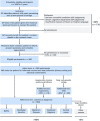Prospective diagnostic accuracy study of history taking and physical examination for adults with vertigo in general practice: study protocol
- PMID: 38569697
- PMCID: PMC10989125
- DOI: 10.1136/bmjopen-2024-085715
Prospective diagnostic accuracy study of history taking and physical examination for adults with vertigo in general practice: study protocol
Abstract
Introduction: Vertigo is a prevalent and burdensome symptom. More than 80% of patients with vertigo are primarily treated by their general practitioner (GP) and are never referred to a medical specialist. Despite this therapeutic responsibility, the GP's diagnostic toolkit has serious limitations. All recommended tests lack empirical evidence, because a diagnostic accuracy study on vestibular disorders ('How well does test x discriminate between patients with or without target condition y?') has never been performed in general practice. The VERtigo DIagnosis study aims to fill this gap.
Methods and analysis: We will perform a diagnostic accuracy study on vertigo of primary vestibular origin in general practice to assess the discriminative ability of history taking and physical examination. We will compare all index tests with a respective reference standard. We will focus on five target conditions that account for more than 95% of vertigo diagnoses in general practice: (1) benign paroxysmal positional vertigo, (2) vestibular neuritis, (3) Ménière's disease, (4) vestibular migraine (VM) and (5) central causes other than VM. As these five target conditions have a different pathophysiology and lack one generally accepted gold standard, we will use consensus diagnosis as a construct reference standard. Data for each patient, including history, physical examination and additional tests as recommended by experts in an international Delphi procedure, will be recorded on a standardised form and independently reviewed by a neurologist and otorhinolaryngologist. For each patient, the reviewers have to decide about the presence/absence of each target condition. We will calculate sensitivity, specificity, predictive values, likelihood ratios and diagnostic ORs, followed by decision rules for each target condition.
Ethics and dissemination: The study obtained approval from the Vrije Universiteit Medical Center Medical Ethical Review Committee (reference: 2022.0817-NL83111.029.22). We will publish our findings in peer-reviewed international journals.
Trial registration number: ISRCTN97250704.
Keywords: Adult otolaryngology; Primary Care; Primary Health Care.
© Author(s) (or their employer(s)) 2024. Re-use permitted under CC BY-NC. No commercial re-use. See rights and permissions. Published by BMJ.
Conflict of interest statement
Competing interests: None declared.
Figures


References
Publication types
MeSH terms
Associated data
LinkOut - more resources
Full Text Sources
Medical
Research Materials
Miscellaneous
